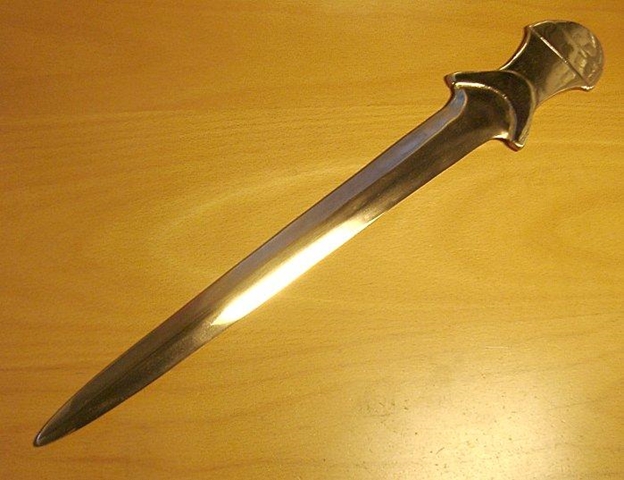






No matter what historical martial art you examine, you will encounter swords, sooner or later - you either use them or learn how to defend against them. Same thing happens in stories, from old sagas all the way up to computer games, any significant and/or named weapon is probably a sword. Take the Hobbit movies, for example: out of four named weapons, three are swords, and the last one is ballista - and that is probably only because a sword can't do much to a dragon - well, except manicure.
This swordy obsession isn't only seen in Europe, whether they are indian tulwars, chineese jians, japaneese katanas or persian shamshirs, swords have consistently higher status, so to speak, than other weapons. Just try to think of, say, five named weapons that are not swords.
Well, why is it always swords, then? We could say that Europe had knights and knights used swords and swords caught their status by association, just like samurai and katanas, but that doesn't really explain, say, China, and, more importantly, ignores that many nations that were more or less unrelated, all decided that swords were pretty cool.

Naturally, people noticed, and I have encountered several theories and explanations while sailing the waters of internet, and while you may or may not agree with them, they are at least an interesting topic to debate.
Looking for the right questionSince we are trying to find out why sword became so legendary in so many different cultures, logical first step is to try and find out something all these cases have in common. As it turns out, it's not a very long search.
First thing they have in common is people using them - they were always a strongly militarized class, or at least they pretended to be. And yet, sword is almost always a secondary weapon for people doing the actual fighting, be they knights or samurai.
Probably the only exception are Romans, who exchanged spears for swords after running into maneuverability problems on uneven ground, and you could still argue that main weapon of legionaries was pilum, not gladius.
As it turns out, our question changed a bit: what makes swords so good, that so many angry men chose them as their secondary weapon? Let's have a look at some possibilities.

A sword is a weapon of many uses - it can stab, slash, cut, strike with the pommel, it works reasonably well on foot, in the saddle or on the deck of a ship.
If you know what you are doing, it can be effectively used against armor, and before you ask, yes, japaneese had half-swording (grabbing the blade with your off hand for stronger and more precise stabbing) too. Hey, I was as surprised as the next guy when Jaro from Aikido dojo Uzumaki showed me.
2. SpecializationSword is the first type of weapon intended solely to be used only against other people. An axe can be used to chop wood, knife or dagger can be used as tools, and spear and bow are hunting weapons. And while you do have axes or knives that can't really be used for things other than fighting (like messer or pollaxe), you can still see the lowly wood-chopper in them - at least people in general certainly will.
Thanks to this, you could see two basic kinds of people with swords: soldiers and robbers, both being a job (or “job”) that involved an awful lot of hitting other people with various objects.
3. UngraspabilityWell, that's a mouthful. What it means is, if you look at any statistic dealing with attacks with a melee weapon against an unarmed opponent (hm, perhaps victim is more appropriate here), no matter if modern police records or historically documented cases, you will find out that most of the victims' wounds, at least if the victim had an opportunity to fight back, are so-called defensive injuries, caused by the victims' attempt to grab the weapon. If you have to choose if you want to have that dagger embedded up to the crossguard in your forearm or in your head...

This kind of grabbing is somewhat inconvenient for the attacker - he would rather stab the poor bastard a bit more - and sometimes even lethal, especially if he is disarmed by it, or if he gets distracted and the victim has a friend with a shotgun nearby.
Swords have a distinct advantage here - mostof their length is sharpened on at least one side, and grabbing something like this without getting injured is, while possible, much harder. And making things harder for my opponent is a pretty nice thing to do in a fight.
4. ConvenienceThis is one of those things that is easily forgotten, how comfortable is a weapon to wear around. After all, most of the time you spend with weapon isn't spent by fighting, but by marrching and other related activities - for example, latrine duty (yes, yes, a knight has people to do that for him, but they can still often had swords of their own) or shopping in the city. The mead won't carry itself back to the camp, you know, and devious enemy would certainly like to get his hand on it.

And sword is pretty comfortable to wear - unlike polearms, it leaves both of your hands free (the mead has been doubled!), and you can quickly draw it, if need be - even Europe has some hints of draw-cutting, but EU iaido is a topic for another article.
And so it was that when your average person saw a knight or soldier, it was with a sword at his side - an easily carried sidearm used mainly for personal defense.
In conclusionThere is no real true reason why swords became legendary - at least, I don't think we'll ever know. Maybe it wasone of these reasons, maybe a combination of several, or something I didn't think of at all. I believe that it was all of these factors, most important among them being convenience of carrying. Be that as it may, this topic is an interesting one to debate with a mug of beer or mead in your hand - or soda, if you aren't over 18, or whatever the drinking age may be where you live.
All Rights Reserved.


